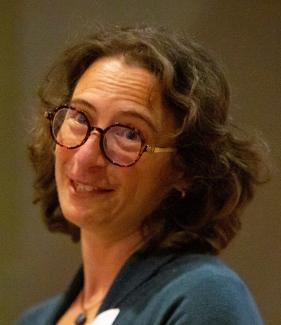Event
Physical Chemistry Seminar: Dr. Naomi Ginsberg, University of California, Berkeley
"Following formation and function of bottom-up assembled nanomaterials"

Abstract
-Design advances for the bottom-up assembly of functional nanomaterials1 have generated a wide range of fundamental questions that must be answered to continue to advance material properties, such as strong electronic and mechanical coupling: What phase behaviors emerge from introducing semiconductor nanocrystals dressed only in short, highly charged ligand coats into electrolyte solutions composed of similar ions not much smaller than the nanocrystals themselves? Specifically, by what complex electrostatic and steric solvation mechanisms are the nanocrystals either colloidally stabilized or destabilized to form other phases of matter? Furthermore, what are the physical properties of these resulting liquids, solids, or non-equilibrium arrested states of nanocrystal building blocks and how can they themselves interconvert? How are the interactions of these nanocrystals with one another mediated through their interactions with the electrolyte? We address these important questions through a multiscale suite of hard X-ray scattering experiments ranging from small- to wide-angle, incoherent to coherent, and storage ring to free electron laser. Together, these experiments reveal the curious solvation shells, non-invasively follow the kinetics of phase transformations in real-time, and observe the minute fluctuations of the nanocrystals in the various phases. Tying our findings together deepens our mechanistic understanding of the phase behavior in order to control the bottom-up assembly of new classes of strongly coupled functional materials.
Energy transport in these and other materials is an important emergent property to also characterize at the nanoscale, especially since the solids created often still contain nanoscale heterogeneities. I will therefore also share recent advances in tracking the motion of ions and photogenerated charge carriers, excitons, and heat using time-resolved optical elastic scattering.2 I will not only show how these forms of energy navigate through heterogeneous landscapes but also how we sensitively measure dynamic temperature changes over the course of photogenerated energy transduction in conducting and semiconducting materials, introducing a unique form of nanoscale non-contact thermometry.
1. Coropceanu, I. et al. Self-assembly of nanocrystals into strongly electronically coupled all-inorganic supercrystals. Science 375, 1422–1426 (2022).
2. Delor, M., Weaver, H. L., Yu, Q. & Ginsberg, N. S. Imaging material functionality through three-dimensional nanoscale tracking of energy flow. Nat. Mater. 19, 56–62 (2020); Utterback, J. K. et al. Nanoscale Disorder Generates Subdiffusive Heat Transport in Self-Assembled Nanocrystal Films. Nano Lett. 21, 3540–3547 (2021).
Bio
Naomi S. Ginsberg is a Professor of Chemistry and Physics at University of California, Berkeley and a Faculty Scientist in the Materials Sciences and Molecular Biophysics and Integrated Imaging Divisions at Lawrence Berkeley National Laboratory, where she has been since 2010. She currently focuses on elucidating electronic and molecular dynamics in a wide variety of soft electronic and biological materials by devising new electron, X-ray, and optical imaging modalities to characterize dynamic processes at the nanoscale, as a function of their heterogeneities and over a wide range of time scales. Naomi received a B.A.Sc. degree in Engineering Science from University of Toronto in 2000 and a Ph.D. in Physics from Harvard University in 2007, after which she held a Glenn T. Seaborg Postdoctoral Fellowship at Lawrence Berkeley National Lab. Her background in chemistry, physics, and engineering has previously led her to observe initiating events of photosynthesis that take place in a millionth billionth of a second and to slow, stop, and store light pulses in some of the coldest atom clouds on Earth. She is the Berkeley lead of STROBE, a multi-university NSF Science and Technology Center devoted to imaging science, a member of the Kavli Energy Nanoscience Institute at Berkeley, and the recipient of a David and Lucile Packard Fellowship in Science and Engineering (2011), a DARPA Young Faculty Award (2012), an Alfred P. Sloan Foundation Fellowship (2015), and a Camille Dreyfus Teacher-Scholar Award (2016) in addition to a series of teaching awards in the physical sciences and the campus-wide Carol D. Soc Distinguished Graduate Student Mentoring Award (2022). In 2017-18 she was a Miller Professor for Basic Research in Science at UC Berkeley and was designated a Kavli Fellow. In 2019 she was the Kroto Lecturer in Chemical Physics at Florida State University. She is the recipient of the 2020 ACS Early-Career Award in Experimental Physical Chemistry and became a Fellow of the American Physical Society in 2021.
HOST: Prof. Fakhraai
Co-sponsored by VIEST
Vagelos Institue for Engery Science and Technology
